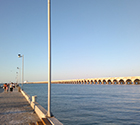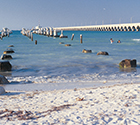Progreso Pier
Seventy five years ago it was decided to construct a pier into the Gulf of Mexico to allow the import and export of material to and from the Yucatán Peninsula. Nickel-containing stainless steel reinforcing bar was specified. A recent ISO-consistent peer-reviewed Life Cycle Assessment (LCA) shows that the selection of stainless steel—in place of the usual carbon steel—has been a productive investment for Mexico and the least demanding on the environment.
Pictures courtesy of Wikimedia Commons and the Nickel Institute.
For more information on the ISO-consistent peer-reviewed LCA, click here.
More details on the project, click here.
An LCA and LCC case study of the Pier is also available, click here.


